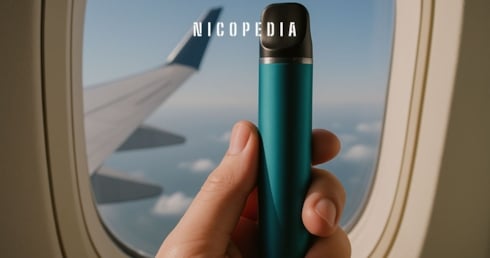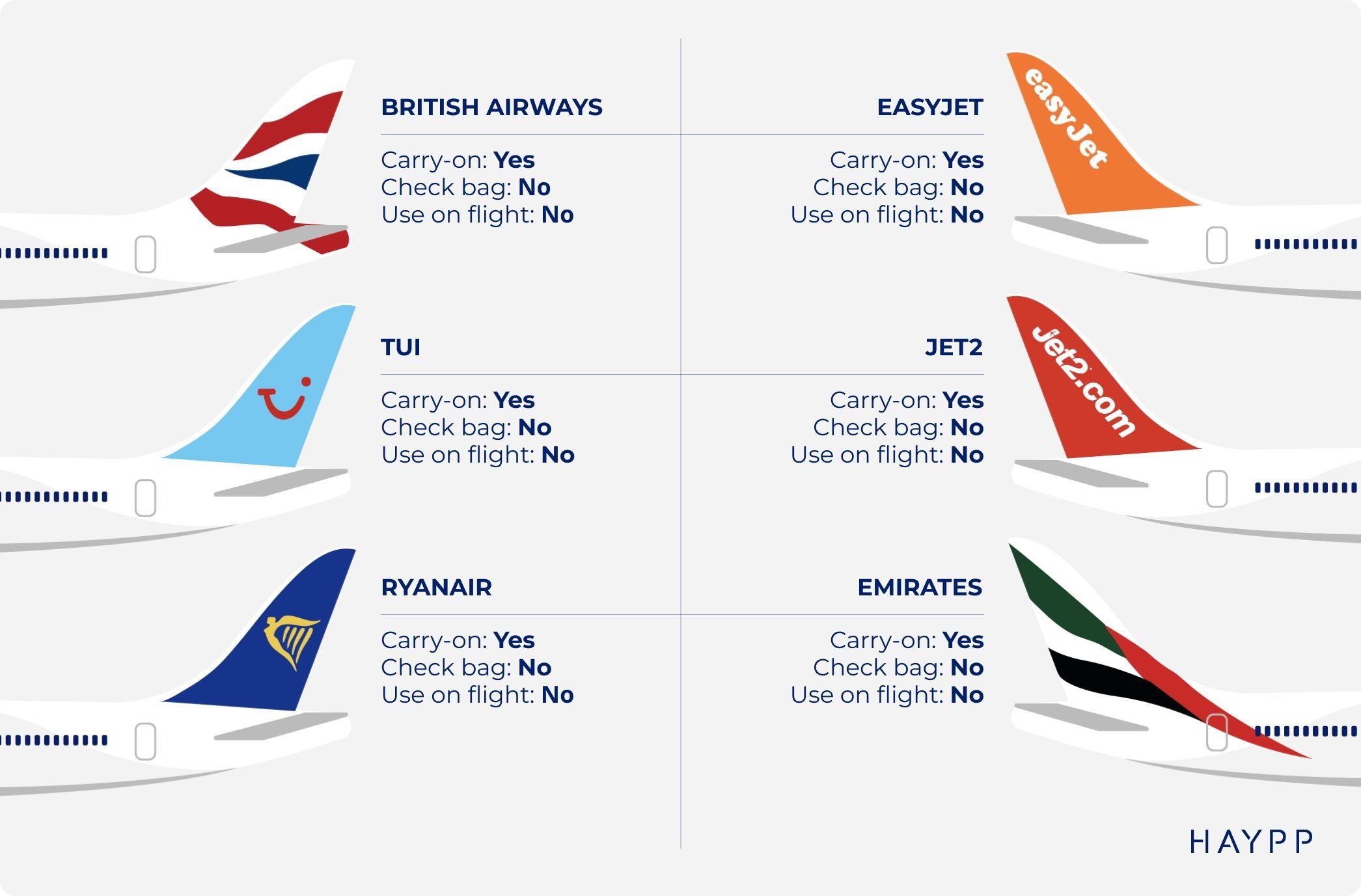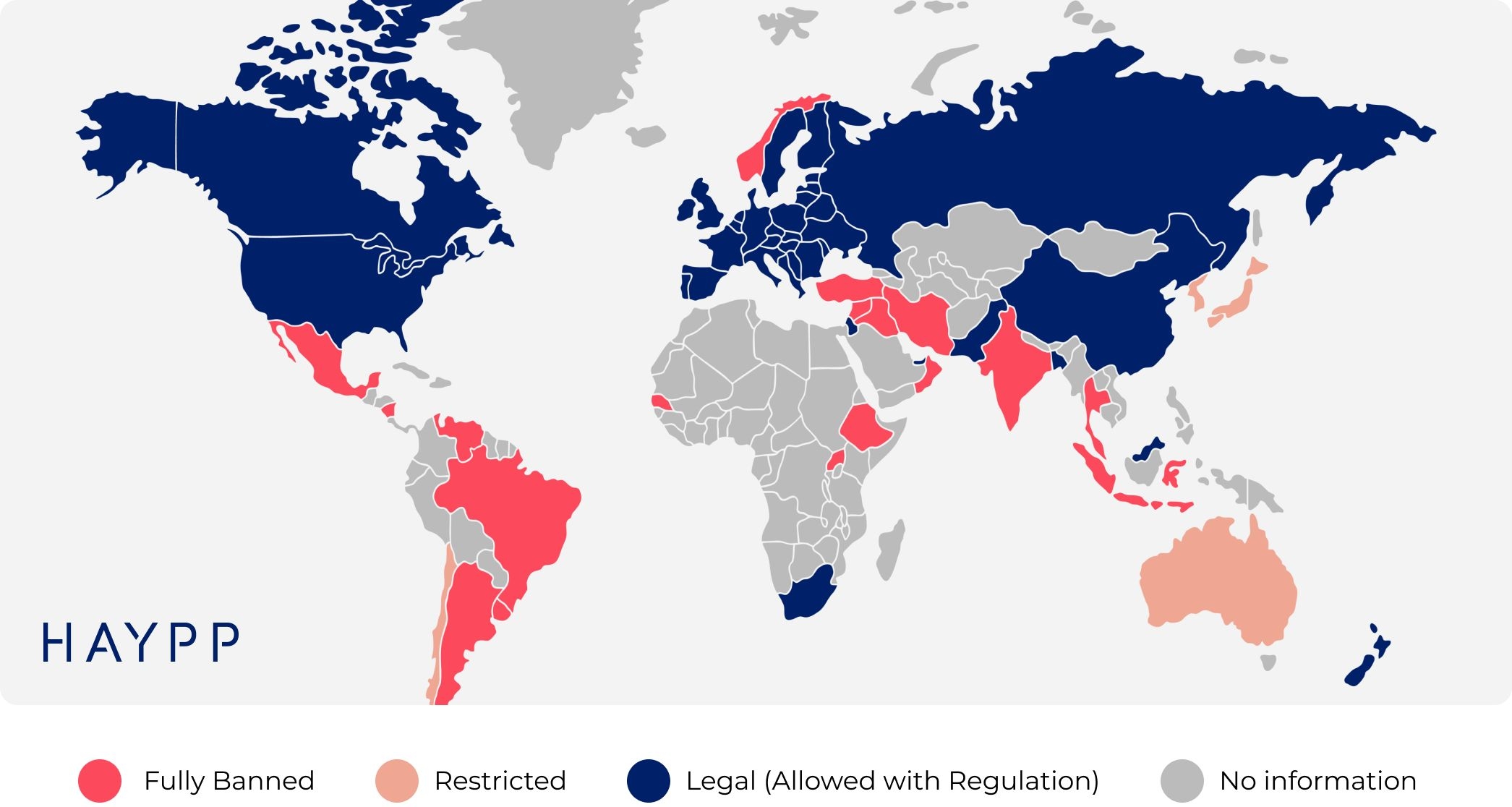Hi! Did you know that you can easily reorder a previous order on My Pages? Just click “reorder” to get all your favourites delivered again.
Published 2025-06-05
Can You Take Vapes on a Plane? (2025)
Jetting off on your holidays? Planning to take your vape? This guide is for you! While the rules are a little ambiguous, you can take most vapes on planes, but there are some things to consider before packing.

An Overview of Vapes on a Plane: Can You Put Vapes in Your Suitcase? Can You Take Disposable Vapes on a Plane? How Many Disposable Vapes Can I Take on an Airplane? Can You Put Disposable Vapes in Your Suitcase? Can You Take Vape Pods and Kits on a Plane? How Many Vape Pods Can I Take on an Airplane? Can You Put Vape Pods and Devices in Your Suitcase? How to Pack Your Vapes UK Airline Vaping Regulations Vaping Policies at Major UK Airports Vaping Laws Around the World: Where You Can and Can’t Vape Final Pre-Travel Checklist
An Overview of Vapes on a Plane: Can You Put Vapes in Your Suitcase?
If you are looking for a quick overview on the rules for carrying vapes on planes, here is a quick guide to help you navigate which suitcase to pack your vapes in:
| Vape Product | Checked Luggage | Carry-On Luggage |
| Disposable Vapes | No | Yes |
| Vape Pods | No | Yes |
| Vape Pod Kits | No | Yes |
| Vape Batteries | No | Yes |
| Vape Juice | No | Yes (≤100ml) |
Note: All e-liquids must be in containers of 100ml or less and placed in a clear plastic bag for security screening.
Can You Take Disposable Vapes on a Plane?
Yes, in most cases you can take your disposable vape on a plane. However, you cannot use it in the airport (other than in designated smoking areas) and must take it in your hand luggage. It is also important to remember that disposable vapes contain e-liquid— so you need to put them in the clear plastic bag at security, and you must make sure they are in a leakproof bag! It is best to keep your disposable vapes in their original packaging when travelling so that security can find the ingredients list and identify the vape, so you don’t have it taken away.
It is important to remember—while you can bring a disposable vape on an airplane, you should never use your vape on a plane as it is illegal.
How Many Disposable Vapes Can I Take on an Airplane?
According to the UK Government, you are allowed to take your vape device when you travel, but you must always keep it with you - you cannot put any vape devices in your checked-in luggage. They also say you should check with the airline you are flying with before you travel as their policies may differ on what vapes and how many disposable vapes you can travel with. Typically though, you can fit around 15 to 20 disposable vapes in your carry-on luggage (as they all need to be in a clear plastic bag for security, as they contain liquids!).
Can You Put Disposable Vapes in Your Suitcase?
In short: you can put disposable vapes in your carry-on suitcase, but not in any checked-in suitcase. Vapes, like most electronic devices, usually have lithium batteries that make them a potential fire hazard and is the reason they cannot be kept in your checked-in luggage.
Can You Take Vape Pods and Kits on a Plane?
Yes, in most cases you can also take your vape pods and vape kit devices on a plane. However, you still cannot use your vape in the airport (other than in designated smoking areas) and must make sure to carry the device and refill pods in your hand luggage. It is also important to remember that the pods contain e-liquid (if they are vape prefilled pods). This means you will need to put them in the clear plastic bag at security and ensure they are sealed/in a leakproof container for travelling (especially if you are using refillable pods and plan to bring a bottle of e-liquid too). It is best to keep your spare pods in their original packaging when travelling so that security can find the ingredients list easily as this means the pods are less likely to be confiscated.
It is important to remember—while you can bring vapes on an airplane, you should never use any vapes on a plane as it is illegal.
How Many Vape Pods Can I Take on an Airplane?
In short, you can travel with as many vape pods as you need (provided they are sealed and fit in your liquids bag at security). According to the UK Government, you are allowed to take your vape device and pods when you travel, but you must keep it with you at all times (so you cannot store any pods or devices in your checked luggage). The UK Government also suggests you check with the airline you are flying with before you travel as their policies may differ on what vapes and how many vape pods you can travel with.
Can You Put Vape Pods and Devices in Your Suitcase?
You can put your vape pods and rechargeable device in your carry-on suitcase, but not in your checked suitcase. These devices have lithium batteries that make them a potential fire hazard and the pods have a risk of leaking.
How to Pack Your Vapes
If you are lucky enough to be taking vapes on a plane, make sure to pack your vapes safely. Wherever you are packing your vapes, make sure that you read our 5 tips for packing your vapes properly:
- Make Sure to Fully Switch off Your Vape Device. Sleep mode won’t cut it; make sure the device, where possible, is fully off.
- Individually Wrap Spare Batteries Before Putting Them in Your Hand Luggage. Most vape batteries contain lithium and can short circuit if you are not careful. This is why it is important to individually wrap any batteries if you plan to carry any.
- Put Any E-liquids in a Clear Plastic Bag if You Carry Them in Your Hand Luggage. Any e-liquids you plan to put in your carry-on bags will need to be 100ml or under and put in a clear plastic bag and remove them when you get to security.
- Empty Any Refillable Pods and Tanks and Place Them in a Leak-Proof Bag or Case. The pressure can cause your tanks to crack or leak, so we suggest you empty your tank before you travel and store them in your hand baggage to avoid any nasty surprises when you arrive.
- Use Protective Cases for Your Devices. To prevent accidental activation and damage, place your vape devices in protective cases.
UK Airline Vaping Regulations
It is always important to check the vape regulations of the airline you are travelling with as well as your final destination before you jet off on your holidays or business trip. Travelling within the UK? Read our guide to UK vaping laws.
So, what are the vaping regulations for some of the major UK airlines? (last updated May 2025)

| Airline | Vape Regulations |
| Aegean | "You can carry electronic cigarettes including e-cigars and other personal vaporizers containing batteries, for personal use, in your carry-on baggage only. It is prohibited to include electronic cigarettes in checked baggage." |
| Air Baltic | "E-cigarettes, including e-cigars, e-pipes, and other personal vaporizers may be carried in the cabin bag only. The batteries must not exceed 2 g of lithium for lithium-metal batteries and 100 Wh for lithium-ion batteries." |
| Air France/KLM | "Electronic cigarettes of all types are only allowed on your person and must be completely switched off. It is recommended that it is in a special case to protect the electronic cigarette. Using and charging electronic cigarettes are prohibited during your flight." |
| Air Malta | "Electronic cigarettes cannot be carried in your checked baggage and must not be used on board our aircraft." |
| British Airways | "Place these items in your hand baggage (not in checked baggage) and protect each of them to prevent accidental activation. If there are any liquid components, you also need to follow the safety requirements for liquids. You cannot use e-cigarettes, vapes or similar items on board." |
| Croatia Airlines | "Electronic cigarettes including e-cigars, e-pipes and other personal vaporizers containing batteries must be in carry-on baggage only. Electronic cigarettes including e-cigars and other personal vaporizers containing batteries are prohibited from use on board by passengers at all times." |
| EasyJet | "You can carry e-cigarettes and a maximum of two spare batteries in your cabin bag – but not in the hold." |
| Emirates | "E-cigarettes containing batteries are allowed only in hand luggage and must be individually protected to prevent accidental activation." |
| Finnair | "E-cigarettes may be transported in carry-on baggage, but may not be transported in checked baggage. Electronic cigarettes may not be used or recharged during the flight." |
| Icelandair | "Battery-powered e-cigarettes may only be carried in the aircraft cabin (in carry-on baggage or on your person)." |
| Jet2 | "E-cigarettes may be carried in cabin baggage providing they are individually protected; however, these are prohibited to be used onboard our aircraft and within airports (unless in designated smoking areas)." |
| Lufthansa | "E-cigarettes and similar vaporising devices powered by lithium batteries are allowed in carry-on baggage only. However, e-cigarettes must be individually protected in such a way that accidental activation is not possible and they must be stowed away during the entire flight." |
| Norwegian | "E-cigarettes are permitted in carry-on baggage, but not in checked-in luggage. E-cigarettes containing batteries must be individually protected to prevent accidental activation. E-cigarettes are not allowed to be used or charged onboard." |
| Pegasus Airlines | "You can only take vapes in your carry-on luggage. E-cigarettes containing batteries must be individually protected to prevent accidental activation. No e-cigarettes can be used on board Pegasus flights." |
| Qantas | "Vapes can only be brought in your carry-on baggage. However, it must be protected to prevent accidental activation. The use and charging of all e-cigarettes and other personal vaporisers are not permitted onboard an aircraft." |
| Ryanair | "You can take e-cigs on the plane but you cannot use them." |
| SAS (Scandinavian Airlines) | "You can take e-cigarettes in carry-on luggage. Electronic cigars, pipes and cigarettes may not be used onboard SAS flights. These items must remain in your carry-on during the entire trip." |
| TAP Air Portugal | "E-cigarettes, including e-cigars, e-pipes and other similar vaporisers are allowed in carry-on luggage only. Each item must be transported safely and must be individually protected to prevent accidental activation. Goods transported must remain stored for the duration of the flight. Smoking is not allowed on the aircraft." |
Vaping Policies at Major UK Airports
As vaping continues to be a topic of debate, it's important to know the specific rules at airports around the UK, especially if you are a vaper who enjoys travelling. Here's a summary of the vaping policies at several major UK airports, including whether vaping is allowed inside terminals and where the designated areas are located.
| Airport | Vaping Policy | Designated Areas | After Security? |
| Heathrow (LHR) | Smoking and vaping are banned inside terminal buildings. | Designated areas available outside terminals. | Not available after security. |
| Gatwick (LGW) | No smoking or vaping inside terminals. | Designated smoking/vaping areas outside terminals only. | None past security. |
| Manchester (MAN) | Prohibited inside all terminal buildings. | Smoking areas outside each terminal. | Not allowed beyond security. |
| Birmingham (BHX) | Vaping not allowed inside the terminal. | Permitted in designated outdoor areas. | No vaping areas past security. |
| Stansted (STN) | Smoking and vaping not allowed inside. | Allowed only in designated zones outside terminal buildings. | None available airside. |
|
Edinburgh (EDI) |
Smoking and vaping are banned inside the terminal. | Permitted outside terminal in marked areas. | No airside smoking areas. |
|
Glasgow (GLA) |
Smoking and vaping are strictly prohibited inside. | Designated smoking zones outside the terminal. |
Not allowed past security. |
Each of these airports has clear restrictions, generally prohibiting vaping inside the terminals and only allowing it in designated outdoor areas. If you’re a vaper, be sure to check the designated smoking or vaping zones before heading to security.
Vaping Laws Around the World: Where You Can and Can’t Vape
Global vape regulations vary widely. According to WHO and tobacco-control surveys, at least 34 countries ban the sale of vapes – including India, Brazil and Thailand – often via laws prohibiting importation, manufacture or retail. In contrast, many countries allow vaping but apply strict tobacco‐style controls (age limits, health warnings, flavour bans, indoor-use bans, etc.). A handful (e.g. Japan, Chile, Australia) restrict e-cigarettes as medical products (prescription/license only). We break down the current legal status of vapes across the globe, highlighting if vapes are Fully Banned, Restrictions in Place, or Legal (allowed with regulation)

Fully Banned
Vaping is completely prohibited – including import, manufacture, sale, and often public use.
Some of the 34 countries where vapes are banned includes:
- Asia & Middle East: India, Thailand, Singapore, Iran, Iraq, Qatar, Sri Lanka
- Africa: Ethiopia, Gambia, Uganda
- Latin America: Argentina, Brazil, Mexico, Nicaragua, Uruguay, Venezuela
- Others: Norway (nicotine vapes), Turkey, Taiwan, Hong Kong (SAR), Macau (SAR), Brunei, Lebanon, Syria, Vanuatu
Restrictions in Place
Vaping is allowed under medical or tight government control – may require prescriptions, licenses, or only be sold via pharmacies.
Some of the countries that have strong restrictions on vape products includes:
- Australia – Pharmacy-only, import and flavour limits, nicotine ≤20mg/ml
- Chile – Nicotine vapes classed as medicines; no approved commercial sales
- Japan – Nicotine vapes treated as medicine; only nicotine-free sold domestically
- South Korea – Prescription needed for some vapes; synthetic loopholes under review
Legal (Allowed with Regulation)
Vaping is legal with standardised controls such as age limits, health warnings, flavour restrictions, or sales regulations.
Some of the countries that allow the sale of vapes with standard controls include:
- North America: United States, Canada
- Europe: United Kingdom, EU member states, Russia
- Asia-Pacific: New Zealand, China, Malaysia (as of 2024), Bangladesh, Pakistan
- Middle East & Africa: Israel, UAE, South Africa
Final Pre-Travel Checklist
Before embarking on your journey, ensure the following:
- Check Airline Policies: Confirm the airline's regulations regarding carrying and using vaping devices.
- Understand Airport Rules: Familiarise yourself with the departure and arrival airports' policies on vaping.
- Research Destination Laws: Investigate the vaping laws of your destination country to avoid legal issues.
- Pack Appropriately: Ensure all devices are turned off, batteries are protected, and e-liquids are within the allowed limits. You could also consider trying out nicotine pouches if you cannot bring vape products!

FAQ: Can I Take Vapes on a Plane?
How Many Vapes Can You Take on a Plane?
There is no official limit on the number of vapes you can carry, but most airlines recommend keeping it to a reasonable quantity for personal use. Typically, you can bring multiple vapes in your hand luggage but always check with your airline for specific regulations.
Can You Take Vapes on a Plane in the UK?
Yes, you can take vapes on a plane when flying from or to the UK. However, all vapes must be packed in your hand luggage, not checked luggage, and you should ensure the e-liquid is under the allowed limit for liquids (usually 100ml per container).
Can You Take Vapes in Hand Luggage?
Yes, vapes must be carried in your hand luggage, as they are not allowed in checked baggage. Ensure your vape and any e-liquid comply with airport security rules, including liquid restrictions.
How Many Vapes Can I Take on a Plane?
You can bring multiple vapes on a plane, if they are for personal use. Be mindful of the airline’s policies and any liquid restrictions for e-liquids, which should not exceed 100ml per container.
Can I Take Vapes On A Plane?
Yes, you can take vapes on a plane, but they must be packed in your hand luggage. Be sure to follow the airline’s rules regarding vaping and the transportation of e-liquids.
